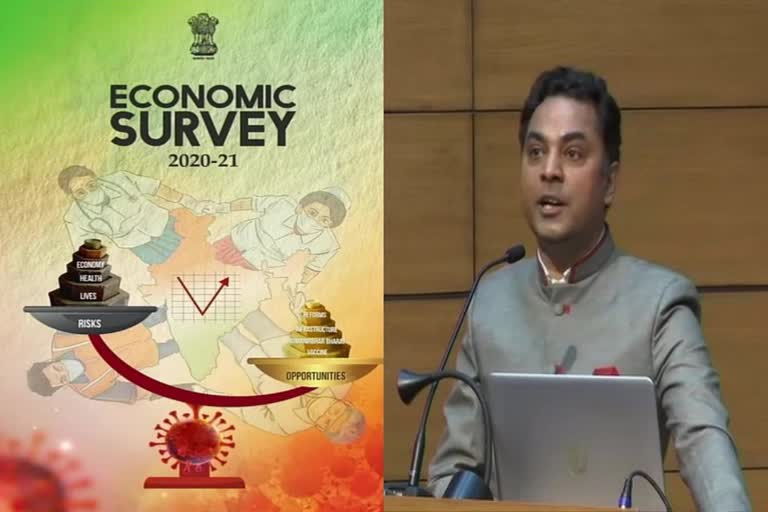Business Desk, ETV Bharat: The Economic Survey 2021 presented today by Chief Economic Advisor, Krishnamurthy Subramanian highlighted the key economic issues faced by the Indian economy battling with the coronavirus pandemic.
Here are the important highlights of the survey:
- GDP: The survey asserted that India's economic growth is likely to rebound with a 11 per cent growth in FY22 as it makes a 'V-shaped' recovery after witnessing a pandemic-led carnage. The Gross Domestic Product (GDP) is projected to contract by a record 7.7 per cent in the current fiscal ending March 31, 2021. The survey also said the agriculture sector is the only silver lining while services, manufacturing and construction were most hit by the lockdown that was imposed to curb the outbreak of the COVID-19 pandemic. The Economic Survey highlighted that India is reaping the "lockdown dividend" from the preventive measures it adopted at the onset of the COVID-19 pandemic indicating its willingness to take short-term pain for long-term gain. India's lockdown strategy prevented 37 lakh COVID-19 cases and 1 lakh deaths, it added.
- Healthcare: As per the survey, an increase in government spending on the healthcare sector - from the current 1 per cent to 2.5-3 per cent of GDP - as envisaged in the National Health Policy 2017 could reduce out-of-pocket expenditures. The survey noted that the rise in public spending can lead to a reduction in expenditures from 65 per cent to 30 per cent of overall healthcare spend. For the country to effectively respond to future pandemics, the country's health infrastructure needs to be agile, it further added.
- PM-JAY: The health outcomes of the states that adopted Pradhan Mantri Jan Arogya Yojana (PM-JAY) improved when compared to the states that did not adopt the scheme, according to the Economic Survey 2020-21. States that adopted the PM-JAY experienced greater penetration of health insurance and a reduction in infant and child mortality rates, as well as realised improved access and utilisation of family planning services, and greater awareness about HIV/AIDS, it added. According to the survey, even though only a short time has elapsed since its introduction, the effects that are identified by it underscores the potential of the programme to significantly alter the health landscape in the country, especially for the vulnerable sections.
- Education: The Survey pointed out that the percentage of enrolled children from government and private schools owning a smartphone increased from 36.5 per cent in 2018 to 61.8 per cent in 2020 in rural India. The survey said online schooling, which has taken off in a big way during the COVID-19 pandemic, can help reduce inequalities in educational outcomes if it is well-utilised. To mitigate the effect of COVID-19, Rs 818.17 crore is allotted to states/union territories to promote online learning through digital initiatives and Rs 267.86 crore for online teacher training under Samagra Shiksha Scheme, the survey further said.
- Housing: Giving update about the Pradhan Mantri Awaas Yojana (PMAY), which seeks to provide housing for all in urban and rural areas by 2022, the survey mentioned that under PMAY (Urban), as on January 18, 2021, 109.2 lakh houses have been sanctioned. Out of these, 70.4 lakh houses have been grounded for construction, of which 41.3 lakh have been built to the beneficiaries under PMAY(U) since inception of the scheme in June 2015. The target number of houses for construction under PMAY (Gramin) is 2.95 crore in two phases i.e. 1 crore in Phase I (2016-17 to 2018-19) and 1.95 crore in Phase II (2019-20 to 2021-22).
- Banking: The economic survey said an asset quality review (AQR) exercise must be conducted immediately after the forbearance is withdrawn. It said that the banks exploited the forbearance window for window-dressing their books and misallocated credit, thereby damaging the quality of investment in the economy. It pointed out that gross Non-Performing Assets ratio of Scheduled Commercial Banks has decreased from 8.21 per cent at end-March, 2020 to 7.49 per cent at end-September, 2020. However, the Financial Stability Report (FSR) released by the Reserve Bank of India has indicated that banks' gross non-performing assets may rise to 13.5 per cent by September 2021, from 7.5 per cent in September 2020.
- Farm Laws: The government's annual Economic Survey on Friday strongly defended new farm laws, saying they herald a new era of market freedom which can go a long way in improving lives of small and marginal farmers in India. These legislations were designed "primarily" for the benefit of "small and marginal farmers", which constitute around 85 per cent of the total number of farmers and are the biggest sufferer of the "regressive" APMC-regulated market regime, the survey said.
(With inputs from agencies)



